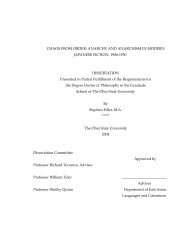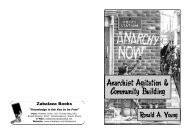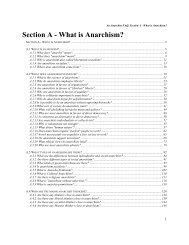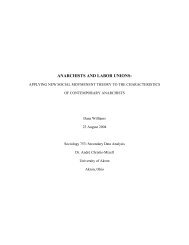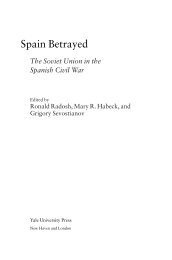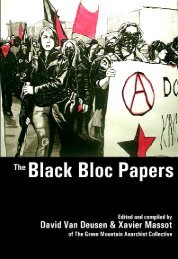Graham Gamblin - Infoshop.org
Graham Gamblin - Infoshop.org
Graham Gamblin - Infoshop.org
Create successful ePaper yourself
Turn your PDF publications into a flip-book with our unique Google optimized e-Paper software.
workers to an acceptance of violence, and with a lack of popular support, to policies<br />
of terrorism, with a view to exacting revenge against their enemies, attracting<br />
attention to their ideas, and sparking a popular revolt. The debates of the Congress of<br />
1881 and those which split Zemlya i volya in Russia in 1879 are also remarkably<br />
similar; while some of the anarchists, such as Kropotkin and Malatesta, wanted to<br />
rebuild a mass, federated movement of workers and peasants, using strikes,<br />
insurrections and economic terrorism, the majority of militants seemed bent on using<br />
small, secret cells of professional revolutionaries using dynamite to attack the state<br />
and the ruling class. Indeed, the focus seemed to have shifted from direct action by<br />
workers and peasants, without mediation or representation, to direct action by the<br />
anarchists, without any interference from their supposed constituencies. Nevertheless<br />
I would have to question Fleming's claim that anarchist theory, due to its espousal of<br />
individual autonomy, meant that anarchists had to accept terrorism. 73 This ignores the<br />
debates going on in anarchism at the time, and the fact that anarchist theory contained<br />
competing tendencies. Kropotkin's non-condemnation of the attentats was based on a<br />
refusal to condemn the desperate acts of the impoverished and oppressed, which were<br />
a mere precursor to a broader revolutionary movement; a sign of the times so to<br />
speak. This did not mean that terror should be elevated into a conscious tactic by the<br />
revolutionaries themselves. However the link between terrorism and those anarchists<br />
who denied the use of any broad <strong>org</strong>anisation and espoused complete individual<br />
autonomy ("amorphousness") is correct.<br />
In Russia, the majority of the Zemlevol'tsy, recognising their failure to build a<br />
mass movement and desiring to attack the government directly, proposed an adoption<br />
of terrorism and regicide, cutting themselves off from the mass of the peasantry and<br />
taking the revolutionary struggle entirely onto their own shoulders. In both cases, a<br />
minority defended the more traditional methods of propaganda and <strong>org</strong>anisation<br />
among the people, with little success. These minorities did not deny violence; all<br />
recognised that at some point a violent revolution would have to be undertaken. The<br />
point of debate in both movements was not over the use of violence per se, but rather<br />
over the aims of violence (political vs. socio-economic change) and the related issue<br />
of who was to carry out that violence, a mass popular <strong>org</strong>anisation or a clandestine<br />
revolutionary group, and the targets- economic exploiters or political and state<br />
73 Fleming, op.cit. p.25<br />
31



